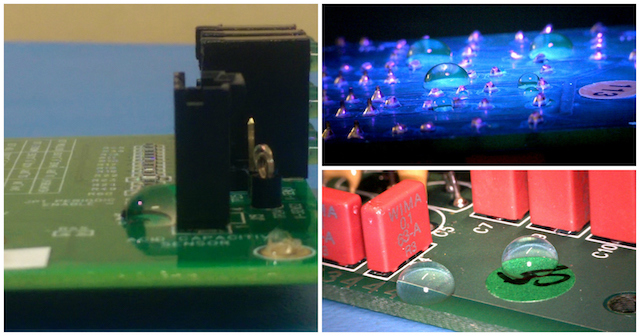Fluoropolymer Nano-Coatings
Exceptional Water and Oil Repellency
At SCH Technologies, we supply ultra-thin Nano-coatings based on advanced fluoropolymer chemistries. These coatings provide a cost-effective way to protect printed circuit board assemblies (PCBAs) and other electronics from moisture, corrosion, and environmental damage.
Key Benefits
- Hydrophobic & Oleophobic Protection – Repels both water and oils to create a strong moisture barrier and prevent corrosion.
- Ultra-Thin Application – Provides protection without the need for masking, even on sensitive areas such as connectors. This eliminates one of the largest costs in conformal coating production—labour-intensive masking and de-masking.
- Versatile Performance – Available with specialist properties including high and low temperature resistance, UV stability, high lubricity, and hardness options ranging from ultra-soft to extremely hard for surface durability.
- Custom Formulations – Tailored chemistries can be developed to meet the unique requirements of your project or application.
Fluoropolymer coatings offer a reliable, low-cost alternative to traditional conformal coatings—delivering high performance protection while simplifying production and reducing costs.

Nano-coating range
Our fluoropolymer Nano-coating portfolio includes:
- LT Series Nano-coating – Room temperature cure
- UVX Nano-coating – UV-cure technology
- OPX Nano-coating – Sub micron protection
These coatings have already proven themselves across a wide variety of circuit boards, and they consistently deliver reliable performance while solving common protection challenges. Because of this track record, we confidently recommend the right Nano-coating for your project, while at the same time ensuring you retain complete flexibility in your options.
Why use Nano-coatings to protect circuit boards?
Ultra-Thin Coatings are part of the liquid protective coating family, similar to conformal coatings, but with distinct advantages for protecting printed circuit board assemblies (PCBAs).
Thanks to their advanced fluoropolymer chemistry, ultra-thin coatings provide a unique set of properties, including:
- Hydrophobic & Oleophobic Behaviour – Repel both water and oils for superior protection.
- Moisture & Corrosion Resistance – Form an effective barrier against environmental damage.
- No Masking Required – Ultra-thin layers protect without contaminating connectors or sensitive areas.
- Enhanced Performance – Excellent chemical resistance, lubricity (low friction), and strong dielectric properties.
Because of their versatility, fluoropolymer coatings are used by SCH across a wide range of engineering projects and industries—delivering reliable, high-performance protection where traditional coatings may fall short.
Fluoropolymer Nano-Coatings – FAQs
What are fluoropolymer nano-coatings?
These types of conformal coatings are ultra-thin protective films that shield printed circuit boards (PCBAs) and electronics from moisture, corrosion, and environmental damage. They provide advanced hydrophobic and oleophobic protection while simplifying the production process.
How do nano-coatings differ from traditional conformal coatings?
Unlike conformal coatings, fluoropolymer based materials are applied in sub-micron layers, meaning they protect without masking—even around connectors. This reduces labour, speeds up production, and lowers costs.
What are the key benefits of fluoropolymer nano-coatings?
Nano-coatings repel water and oils, resist moisture and corrosion, and offer versatile performance with options for UV stability, temperature resistance, lubricity, and varying hardness levels.
Do nano-coatings require masking?
No. One of the biggest advantages of these materials is that they eliminate the need for masking and de-masking, reducing labour and cutting one of the largest costs in conformal coating production.
What fluoropolymer nano-coating options are available?
- LT Series – Room temperature cure
- UVX – UV-cure technology
- OPX – Sub-micron abrasion-resistant protection
Where are fluoropolymer ultra thin coatings used?
They are widely used in aerospace, automotive, defence, medical, and industrial electronics where reliable protection against harsh environments is required.
Can coatings be customised for specific applications?
Yes. SCH provides tailored formulations to meet unique project requirements, ensuring the right chemistry for your performance, compliance, or durability needs.
Are nano-coatings cost-effective?
Absolutely. By reducing the need for masking and rework, while providing long-lasting protection, these thin film technologies offer a low-cost alternative to traditional conformal coatings.
Useful links
Why Choose SCH Services?
Partnering with SCH Services means more than just outsourcing — you gain a complete, integrated platform for Conformal Coating, Parylene & ProShieldESD Solutions, alongside equipment, materials, and training, all backed by decades of hands-on expertise.
- ✈️ 25+ Years of Expertise – Specialists in coating technologies trusted by aerospace, medical, defence, automotive, and electronics industries worldwide.
- 🛠️ End-to-End Support – Guidance on coating selection, Parylene grades, masking strategies, application methods, inspection, and ProShieldESD integration.
- 📈 Scalable Solutions – From small prototype batches to full-scale, high-volume production, SCH delivers flexible capacity that grows with your needs.
- 🌍 Global Reach – Responsive technical support and supply coverage across Europe, North America, and Asia.
- ✅ Proven Reliability – A strong reputation built on quality, consistency, and customer satisfaction across services, equipment, and materials.
📞 Call: +44 (0)1226 249019
✉ Email: sales@schservices.com
💬 Contact Us ›

